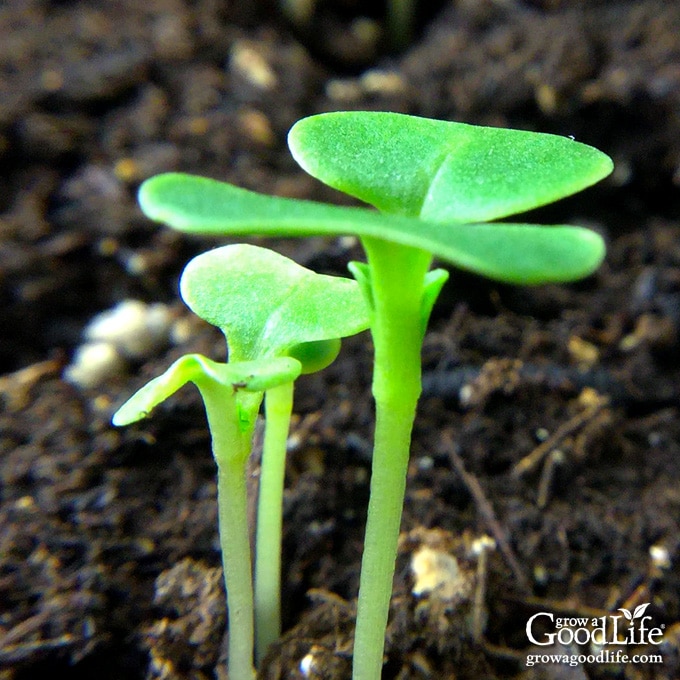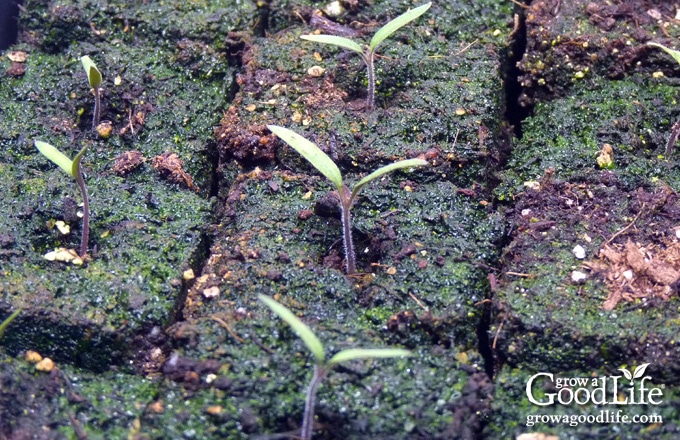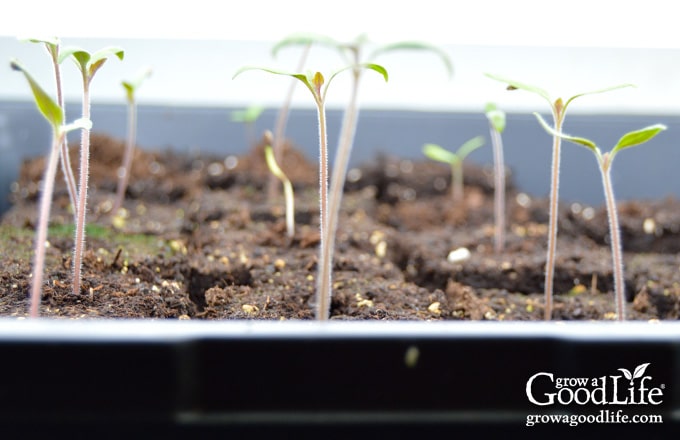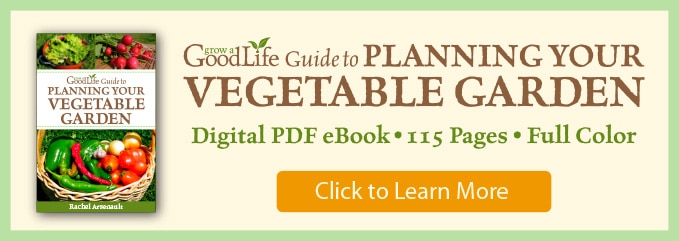Troubleshooting Seed Starting Problems
This post may contain affiliate links, which means that I may receive a commission if you make a purchase using these links. As an Amazon Associate I earn from qualifying purchases.
Growing your own vegetable garden transplants from seed is pretty straightforward, but sometimes you can run into problems. Here’s how to identify and resolve some of the most common seed starting problems you may run into when starting seeds indoors.

There is a special sense of fulfillment when you see the plants you have nurtured from tiny seeds grow and produce bountiful harvests. If you follow these 10 Steps to Starting Seedlings Indoors and you will be off to a good beginning.
Sometimes your seeds fail to germinate, or your seedlings emerge, but struggle and look unhealthy.
There are many reasons why seeds fail to germinate or a seedling suddenly dies before growing into healthy plants. Some of these have nothing to do with you, but there are others that you can prevent with a little knowledge.
Most of the issues that lead to failure have to do with the seed-sowing environment. Here are some troubleshooting tips to help you avoid seed starting problems.
Identifying Seed Germination Problems
There are several issues that can prevent a seed from sprouting. The first step is to use good-quality seeds from a trusted supplier. Some seeds simply have a poor germination ratio, but this should be indicated on the seed package in a statement that may suggest sowing heavily. If you are confident about the quality of your seeds and you still run into problems, review the information below to see if it helps identify your seed starting problems.
Not enough time for the seeds to germinate
The instructions on the seed package indicate how long the seeds will take to germinate. This is only an average time based on perfect growing conditions, such as temperature, moisture, and seed starting medium. Less than ideal growing environments will require added time for the seeds to germinate.
Solution: Give your seeds a few more days.
In addition, consider pre-sprouting your seeds. Pre-sprouting is a method of germinating seeds with a damp paper towel before they are planted into a growing medium. Germination is usually quicker because the seeds are given ideal moisture, air, and temperature conditions.
Seeds are too old or not stored properly
Most seeds can last several years if they are stored away from heat, moisture, and light. Older seeds will have a reduced germination rate. Even if older seeds do germinate, they may not have the vigor to produce healthy plants like when they were new.
Solution: Purchase fresh seeds each year, and test your older seeds to see whether they will sprout. If old seeds do not sprout, replace your inventory with new seeds.
Some seeds like chives, parsley, parsnip, and onions lose viability after only a year. So plan on purchasing fresh seeds each year.
Not enough moisture or too much moisture
Seeds need moisture to germinate, but the seeds will rot if the soil is overly wet. If the seed-starting medium is too dry, moisture will not penetrate the seed coat and signal the seeds to sprout. Saturated soil will cause the seed to rot.
Solution: Pre-moisten your seed starting mix before making soil blocks or filling your seed starting containers. The soil should be damp, but not dripping wet.
After sowing your seeds, cover the tray with a humidity dome to retain moisture. If the soil surface dries out, mist with a spray bottle until it is damp once again. Remove the dome once the seeds sprout and place under lights.
Seeds planted too deep
Each seed has a boost of nutrients to feed it as it germinates and grows into a seedling. Seeds that are planted too deep will struggle to reach the soil surface and may run out of nutrients. If the spout doesn’t reach the surface and receive light, it will die beneath the soil. If the sprout does manage to break through, the struggle can weaken the seedling.
Solution: Refer to the seed package for correct planting depth to sow the seeds. Generally, plant seeds at a depth that is twice the size of the seed. For example, if your seed is 1/4-inches wide, plant it about 1/2-inch deep. It is better to sow seeds too shallow than too deep.
Try not to compress the soil over the seeds as you sow them. The soil should be firm enough to hold in moisture, but not so compacted that the seedling can’t break through.
If your seed packet says your seeds need light to germinate, sow the seeds on top of the soil and use a mister to water them. The gentle shower of water should be enough to push the seeds into the soil. Place the seed containers under lights.
Temperature is too hot or cold
Seeds need heat and moisture to trigger them to sprout. The amount of heat is different for each seed type. If the seeds are sown in soil that is too cold, they may remain dormant or even rot. If the seeds are in soil that is too hot, the heat will kill the seed.
Generally, seeds for cold season plants germinate in soil temperatures of 60-70˚F. Warm season plants germinate in temperatures of about 75-85˚F.
Solution: Check the seed package for the optimal soil temperature for germination. Control the temperature of the area where the seed trays are located. For more warmth, place the seed starting trays in a warm area to germinate or use a heated seed-starting mat to warm the soil. For cooler temperatures, consider locating the seed trays in your basement where it tends to stay cooler.
Diagnosing Seedling Problems
There are other issues that may challenge your seedlings once the seeds germinate, and the plant begins to grow.
Seedlings need light, moisture, warmth, good air circulation, and nutrients to flourish. Maintaining that balance helps your seedlings grow into healthy plants. Often times, the seedlings communicate deficiencies, allowing you time to correct some issues. You just need to know what to look for.
Seedlings sprout then die
Symptoms of damping off usually show themselves quickly. The seed may break the soil surface only to wither and die or a healthy looking seedling may suddenly fall over and die.
Damping-off is a soil-borne fungal disease that affects seeds and new seedlings. It is caused by fungus that thrives in environments with excessive moisture and poor air circulation.
Solution: To help prevent dampening off, be sure to wash your seed starting containers well before using. Also sow your seeds in fresh sterile seed starting mix so you don’t introduce fungus and disease to your vulnerable seedlings. Provide good air circulation and avoid over watering. A sprinkling of cinnamon over the soil surface also seems to inhibit the fungus.
White fuzzy or green mold on the soil
White or green mold on the soil surface is a good indication that the growing medium is too wet. Mold is also caused by fungus that thrives in moist environments. The mold will not harm your plants as long as you take action.
Solution: If you see white or green mold on the soil surface, use a fork to scratch the soil to increase aeration. Then provide good air flow by placing a fan nearby to deliver the seedlings with air movement.
Water your seedlings from the bottom when the soil feels dry. The easiest way to do this is to place your seed-starting container into a tray of warm water and let your plants soak up moisture though the drainage holes for a few minutes. Remove the containers and let the extra water drain. Check your seedlings every day to make sure they don’t dry out.

Leggy seedlings
Tall and droopy growth is a good sign that the plant is not receiving enough light. Direct sunlight from a windowsill may not provide the proper light levels for your plants. Leggy plants have thin, weak stems and large gaps in between leaves. This condition can weaken the plants, stunt their growth, and make them more susceptible to pests and diseases.
Solution: To prevent leggy plants, first make sure they are receiving enough light. Seedlings need at least 12-16 hours of light each day. Use grow lights, and keep the light about 2-inches above the seedlings. Consider adding another lighting fixture, so the plants receive enough light.
If your plants are getting plenty of light, spindly stems may also indicate that the growing medium is too dry, the environment is too hot, too much fertilizer, or the seedlings are overcrowded.
Solution: Keep the growing medium evenly moist, move the seedlings off the heating mat or to a slightly cooler area, cut back on the fertilizer, and avoid overcrowding by thinning the seedlings.

Discolored leaves
Discolored foliage usually indicates a nutrient deficiency. Pale yellow leaves may mean a nitrogen shortage, bronze edges might indicate a deficiency of potassium, and a lack of phosphorus may cause the undersides of the leaves to turn a purple color.
When seeds first germinate, they are able to obtain nutrients from the seed itself. This sustains the seedling through the germination process. When the seedlings begin to form its first true leaves, it is time to supply additional nutrients.
Solution: To avoid nutrient deficiencies, begin a fertilizing routine once the second set of leaves form. Begin with a half-strength, organic fertilizer such as liquid fish fertilizer or worm casting tea. Each brand is different; follow the instructions on the label for best results.
Wilted and dying seedlings
If you have little black flies flying around, you probably have fungus gnats. Fungus gnat damage will look similar to dampening off disease. The plant will sprout and thrive, but may suddenly stop growing, and lower foliage may turn yellow and drop off. The plant will die if the roots are damaged enough to prevent the plant from absorbing moisture and nutrients.
Fungus gnats are minuscule insects that are drawn to light and damp soil. While the flies themselves won’t harm the plants, they do infest plants by laying their eggs in the soil. Once the larvae hatch, it burrows deep into plant’s roots, feeding on plant tissue, and hindering growth. If you have a large infestation, they will kill your seedling.
Solution: Use yellow sticky traps to capture and kill the adults. Start seeds in fresh, sterile seed starting mix. After opening the bag, keep it sealed to stay dry and prevent the flies from laying eggs. When potting up seedlings, use a potting mix that drains well, add a layer of horticultural sand on top, avoid overwatering, and let the surface dry in between watering.
—
I hope these tips help you with identifying and preventing seed starting problems and get your seedlings off to a great growing start.
For the best results, begin with fresh seeds, clean containers, and a good quality seed starting mix. Provide adequate lighting, good airflow, and nutrients. Maintain a consistent temperature, and keep the soil moist, but not too wet. Soon your seedlings will be transplanted to the garden.
You May Also Like:
- Tips for Buying Seeds for Your Vegetable Garden
- How to Develop a Seed Starting Schedule
- 10 Steps to Starting Seedlings Indoors
- How to Harden Off Seedlings Before Planting
Good planning is key to a successful vegetable garden
Whether you are new to growing your own food or have been growing a vegetable garden for years, you will benefit from some planning each year. You will find everything you need to organize and plan your vegetable garden in my PDF eBook, Grow a Good Life Guide to Planning Your Vegetable Garden.


Biggest problem I see people have and have had myself is improper pH. If using a paper towel to germinate in (I think proper pH organic soil is best), you must make the water the proper pH or you will not have as good or possibly any germination rate.
Whenever having any plant issues pH is the first thing to check because good pH is critical for everything.
Very informative post. It captures all the main problems with seed starting. I’m actually having the discolored leaves problem with my adenium desert rose seedlings. I’ll try adding in some more nutrients.